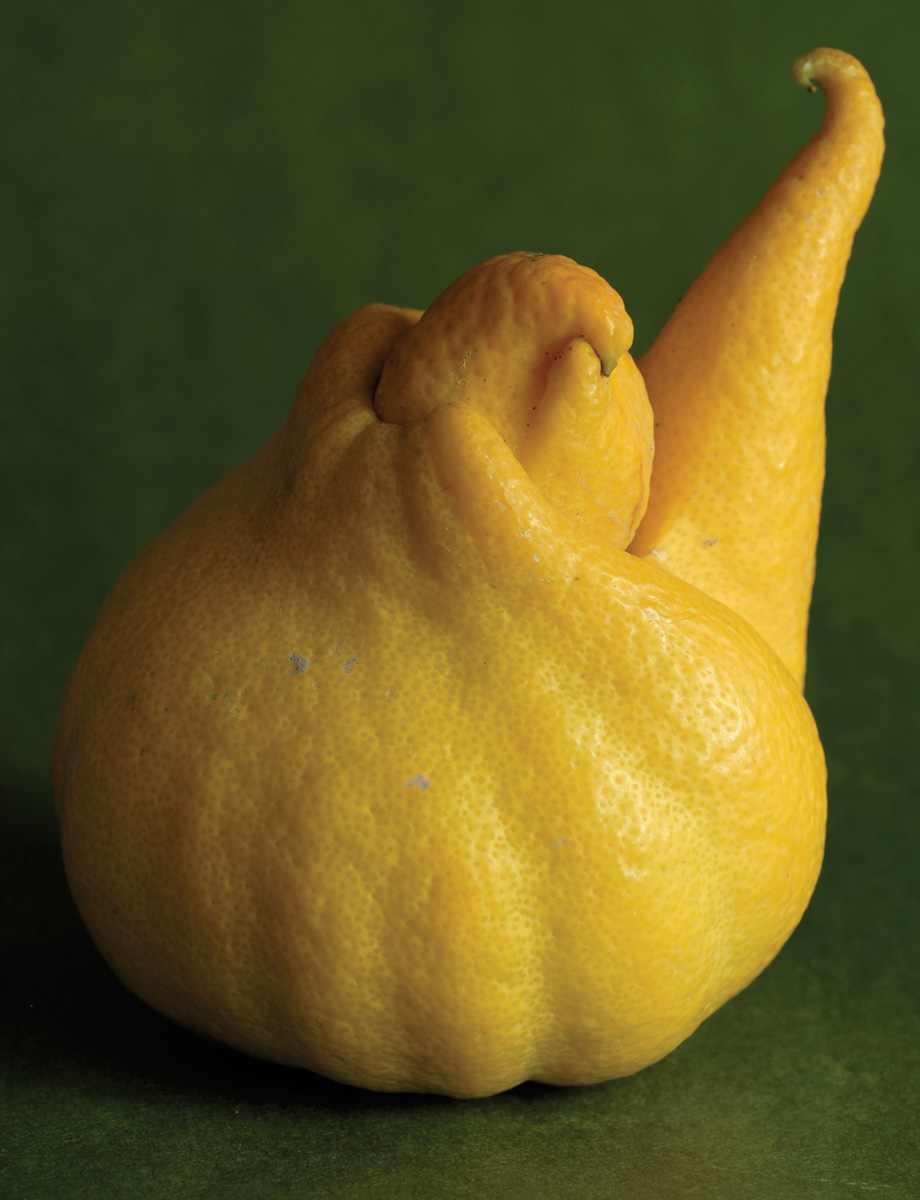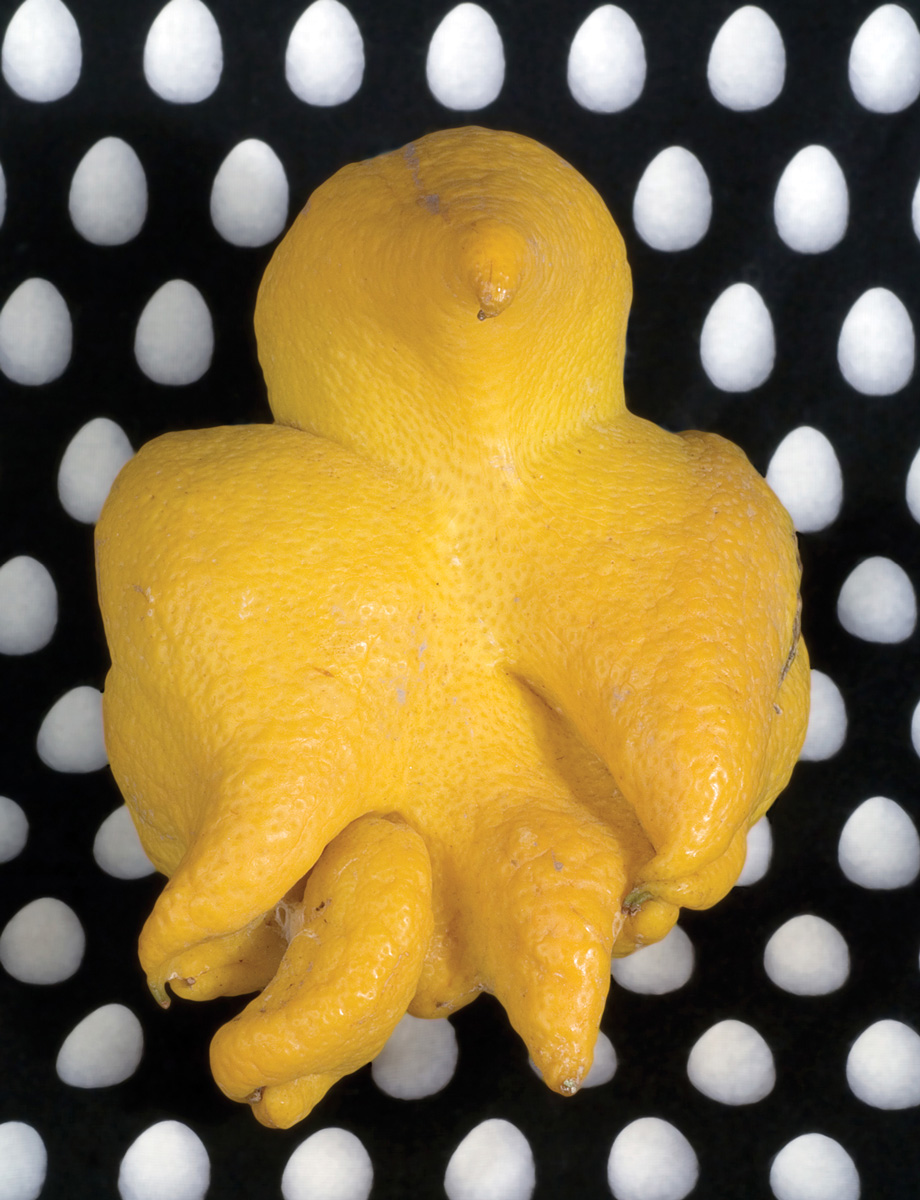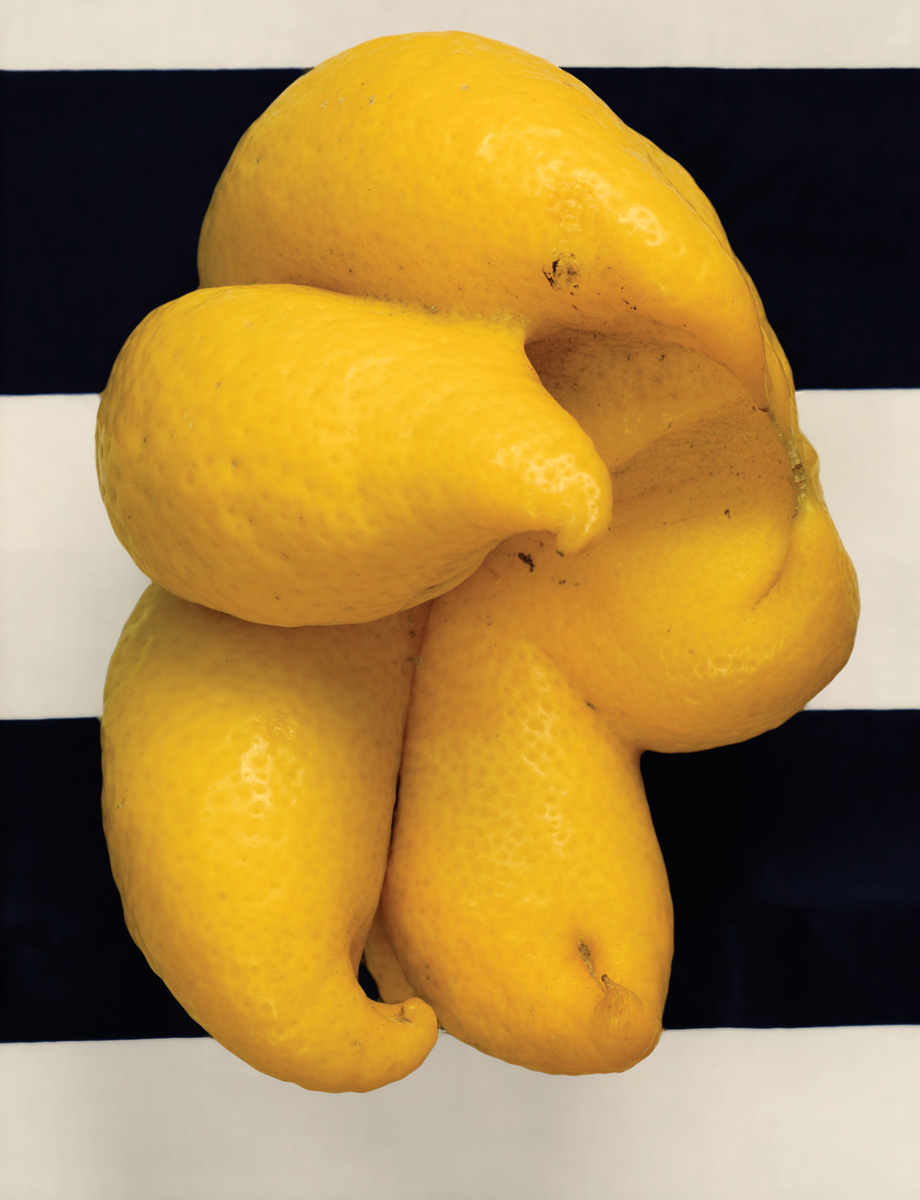Strange Fruit
The Citrus bud mite as sculptor
Ellen Birrell

Consider the common lemon: languishing in unassuming piles or perhaps bagged by the dozen in the flora part of your local market, leafless. You know the shape; the size is not larger than your fist. The thick skin, “lemon yellow” in color, is sometimes fragrant but often not. Cut one open and a good lemon imparts a flavor and acidity of infinite uses in your kitchen so ubiquitous as to be hardly worth mentioning. As a child, I loved to eat them like an orange—the saliva pools beneath my tongue as I remember this.
A transplant from east to west, I go to K-Mart for a Eureka lemon tree, the first occupant of the first garden I make in Southern California. Seventeen years later, the second garden I steward has to have a Meyer lemon, a sweeter variety I notice now becoming popular in upscale specialty markets. Eight years on, now half my life a Californian, my love and I move from the city to a lemon and avocado farm in the heart of the last agricultural county in Southern California. Jumping off the Deep End we call it.
Conversation between my love and our future orchard manager:
“That lemon tree looks really droopy. Maybe it should have some water?”
“That’s an avocado…but of course, you knew that…”
Here’s how commercial lemon farming works: you join a packinghouse. This requires signing a contract that essentially says to the grower, “All the fruit on your trees is ours to pick and market as we see fit.” We decide on a small cooperative packinghouse, rather than the very large commercial packinghouse that has the vast majority of contracts. Joining an operation of that scale is to cede all control of the orchard. We want to farm.
Our farm, Deep End, has about thirty acres planted in my first lemon variety, Eureka. This is the lemon you know from the market. In this microclimate, the trees are ever bearing. That means on any given day, on any one of our 3,500 trees, you might find blossoms opening, green lemons growing, and yellow lemons, also growing. One of the tasks of the lemon farmer is to prune the trees every year to maintain a height not taller than fifteen feet. Left to themselves, Eureka lemons would grow twice that high, as have the few, now ornamental, Valencia oranges left over from the first orchards planted on this land. The height is important: lemons cannot be picked by any mechanical means. Men, wrapped head to toe against thorns, regardless of weather, climb peculiar three-legged stepladders to clip, not pull, each lemon from its limb. This operation takes both hands. The men place the lemons in picker’s bags worn crosswise on their chests and shoulders. These bags, when full, weigh upwards of seventy pounds. They are looking for the perfect lemon. They call it a “nine ring” for the sizing ring that each picker is to slip over the end of the fruit before clipping it. Their job is to pick all the fruit “nine ring” size or larger. Each man is assigned a bin in the field; if they pick fast enough, they may make more than minimum wage. This is terrifically physical labor, and it is done at speed.
As it turns out, the packinghouses rotate their picking crews from orchard to orchard, and there is a terrible labor shortage, made even more acute of late by immigration issues. So we are lucky if we get the pickers four times a year. The fruit gets graded according to three standards: Fancy, Choice, and Juice. Fancy is the essence of lemon-ness, the one you pay top dollar for in the store. Choice is the food service grade—the garnish on your plate, the slice in your water—the largest part of the market for conventionally grown lemons. Since a yellow lemon will continue growing as long as it is on the tree, a good percentage of any pick is graded Juice. Growers hope to not exceed 50%, but the timing of the pick is everything. Juice is where the appearance of the fruit does not matter, as the consumer never sees the Juice lemon. This lemon ends up in anything with natural lemon flavor—soaps, pies, barbeque sauces, sodas, and even those plastic juice bottles shaped like, you guessed it, a perfect nine ring lemon.
Our first pick is in April, the lead edge of the peak demand season for lemons. The fact that we should have been picked in January means that we have a lot of Juice lemons, and as I wander around the groves, I find some of them are exceedingly odd—softball-sized, and football-shaped, with weird ridgy protuberances. Cut open, the fruit part is about the size of a nine ring surrounded by a very thick pith and heavy peel. Great for zest with all that surface area, but I have to use the one-handed orange squeezer, not the smaller lemon squeezer, to extract the juice. Some lemons are so big I simply dig in with my fingers—clearly this is not a convenience food.
We get picked again in late June, and not so many Juice this time, but by the end of the summer while we wait for our third pick, we begin to find we have grown even stranger lemons than our April juicers. Sometimes large, but not always, these lemons are forked, doubled, fingered, twisted, and bizarre. Sometimes they look like an ordinary lemon that has decided to become something else entirely, smack in the middle of being a lemon. Sometimes, they bear no resemblance to a lemon at all, except in their color. My knowledgeable urban gardener friends say, “Buddha Hands,” but these are not citrons; they are lemons. I cut several of them open, and they are perfectly ordinary lemons inside. Even the larger swollen fingers have their good tart lemon segments. I ask our packinghouse guy what’s up. He says, “Bud mites—talk to your entomologist. Perfectly good fruit, though they’ll all be Juice. It’s our own fault for how well we have marketed the nine ring all these years.”
Ah, the pastoral life. We share a well with some rather belligerent neighbors (those are the two-legged kind), and we share our lemons with gophers, rabbits, ground squirrels, and snails—make that a plague of snails—not to mention everything from snakes, deer, coyotes, vultures, owls, and hawks, all the way up the food chain to mountain lions and possibly black bears. Now our entomologist introduces us to a whole other host of neighbors: peel miners, red scale, cottony cushion scale, wooly whiteflies, leaf miners, mealy bugs, skirtle thrips, silver mites, and now bud mites. According to the University of California Integrated Pest Management Program web page, citrus bud mites, a.k.a. eriophyes sheldoni, are microscopic critters with long bodies and four legs next to their mouths that take up residence in the growth union of the bud where the fruit forms.[1] They eat something they like up in there, which does not in itself harm the fruit, but in the process they emit something that the Oxford Journal of Experimental Botany refers to as phenol.[2] Apparently these phenols have a depressive effect on the growth accelerators emitted at the bud union to encourage the even growth of the fruit. So the growing lemon is getting mixed messages: “Grow! Don’t grow!” And these baroque beauties are the result.
As the fall goes on, I see more and more bud mite lemons, bigger and ever more baroque. They are literally fantastic, no two of them alike. The pickers come again and I ask them to save the “bud mites” for me. To save them time, I suggest they drop the fruit on the ground under the trees where I can glean them at the end of each day. But the pickers must be intrigued because at the end of every picking day, the bench outside my studio has a dozen or more of the most extraordinary bud mite specimens left there for me. I meet the pickers in the orchard as I am gleaning. They come down off their ladders to share their wondrous finds. We stand together in the hot sun passing the awkward lemons back and forth.
By New Year’s, the house is full of them. Our cadre of urban aesthetes trek to the country for some exotic R&R and are amazed at the infinite variety of these not-quite-soft sculptures. A bud mite lemon becomes the preferred souvenir of a trip to the farm, the trophy of a successful walk through the orchards. Sad are those who go back to the city without one.
I too am sad, sad to see the bud mite lemons go, to visitors and to the inevitable rot that takes the gloss from their skins, drowning in the blue bloom of mold. The house takes on an odor of rotting lemons. I fill all the refrigerators on the farm with the survivors and turn to the core tool of my artistic practice, photography, to give them the half-life of pictorial memory. I polish and pose them, pair them with flattering backgrounds, and picture them in such a way as to admit of no other distractions. For an artist whose interests have always revolved around the tectonics of nature and culture, I can’t do enough for these lemons, the windfall gifts of becoming a not-artist/not-lemon-farmer.
As I write this, we are between the first and second pick of another year. So far no visible evidence of the mites at work. Deep End is, historically, a conventional farm, but we have decided against using any pesticides—after all, we live here. Our orchard manager and the entomologist recommend we apply an oil spray with a foliar fertilizer. The theory is that the oil will smother enough of the mites to keep the “problem” under control. The Pest Management page says, no way. Me? I’m rooting for the bugs.



- www.ipm.ucdavis.edu/pmg/r107400411.htm [link defunct—Eds.]
- Isaac Ishaaya & Moshe Sternlicht, “Growth Accelerators and Inhibitors in Lemon Buds Infested by Aceria sheldoni,” in The Oxford Journal of Experimental Botany, vol. 20, no. 4 (1969), pp. 796–804.
Ellen Birrell is a lemon farmer and artist in Santa Paula, California. She co-founded and edits X-TRA, a quarterly journal of art and criticism based in Los Angeles. You can find the magazine at www.x-traonline.org.
Spotted an error? Email us at corrections at cabinetmagazine dot org.
If you’ve enjoyed the free articles that we offer on our site, please consider subscribing to our nonprofit magazine. You get twelve online issues and unlimited access to all our archives.